Related Research Articles

The Cambrian Period was the first geological period of the Paleozoic Era, and of the Phanerozoic Eon. The Cambrian lasted 53.4 million years from the end of the preceding Ediacaran Period 538.8 million years ago (mya) to the beginning of the Ordovician Period 485.4 mya. Its subdivisions, and its base, are somewhat in flux. The period was established as "Cambrian series" by Adam Sedgwick, who named it after Cambria, the Latin name for 'Cymru' (Wales), where Britain's Cambrian rocks are best exposed. Sedgwick identified the layer as part of his task, along with Roderick Murchison, to subdivide the large "Transition Series", although the two geologists disagreed for a while on the appropriate categorization. The Cambrian is unique in its unusually high proportion of lagerstätte sedimentary deposits, sites of exceptional preservation where "soft" parts of organisms are preserved as well as their more resistant shells. As a result, our understanding of the Cambrian biology surpasses that of some later periods.

Acritarchs are organic microfossils, known from approximately 1800 million years ago to the present. The classification is a catch all term used to refer to any organic microfossils that cannot be assigned to other groups. Their diversity reflects major ecological events such as the appearance of predation and the Cambrian explosion.
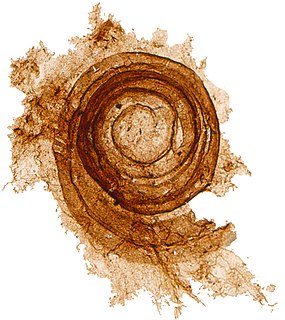
A microfossil is a fossil that is generally between 0.001 mm and 1 mm in size, the visual study of which requires the use of light or electron microscopy. A fossil which can be studied with the naked eye or low-powered magnification, such as a hand lens, is referred to as a macrofossil.

The Tonian is the first geologic period of the Neoproterozoic Era. It lasted from 1000 to 720 Mya. Instead of being based on stratigraphy, these dates are defined by the ICS based on radiometric chronometry. The Tonian is preceded by the Stenian Period of the Mesoproterozoic Era and followed by the Cryogenian.
First appearance datum (FAD) is a term used by geologists and paleontologists to designate the first appearance of a species in the geologic record. FADs are determined by identifying the geologically oldest fossil discovered, to date, of a particular species. A related term is last appearance datum (LAD), the last appearance of a species in the geologic record.
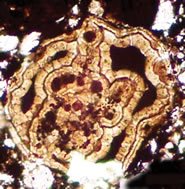
Vernanimalcula guizhouena is an acritarch dating from 600 to 580 million years ago; it was between 0.1 and 0.2 mm across. Vernanimalcula means "small spring animal", referring to its appearance in the fossil record at the end of the Marinoan Glaciation and the belief upon discovery it was an animal.
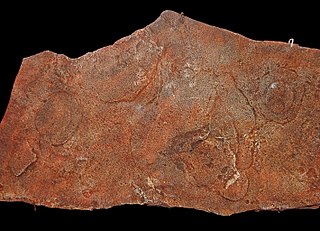
Ediacaria is a fossil genus dating to the Ediacaran Period of the Neoproterozoic Era. Unlike most Ediacaran biota, which disappeared almost entirely from the fossil record at the end of the Period, Ediacaria fossils have been found dating from the Baikalian age of the Upper Riphean to 501 million years ago, well into the Cambrian Period. Ediacaria consists of concentric rough circles, radial lines between the circles and a central dome, with a diameter from 1 to 70 cm.
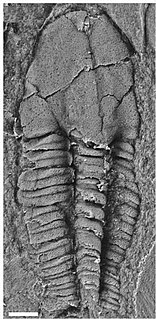
Agraulos Hawle & Corda 1847, is a genus of trilobites that lived during the Middle Cambrian in North America and Europe, particularly the Czech Republic.
Leiosphaeridia is a form-genus of acritarchs proposed by Eisenack in 1958. The grouping was refined to represent a more natural group by Jankauskas.
Evidence suggesting that a mass extinction occurred at the end of the Ediacaran period, 539 million years ago, includes:
The preservational mode of the Doushantuo formation involves very early phosphatisation on a cellular level - with cells being replaced by phosphate before they degrade.
The Great Ordovician Biodiversification Event (GOBE), was an evolutionary radiation of animal life throughout the Ordovician period, 40 million years after the Cambrian explosion, whereby the distinctive Cambrian fauna fizzled out to be replaced with a Paleozoic fauna rich in suspension feeder and pelagic animals.
The Cambrian explosion, Cambrian radiation,Cambrian diversification, or the Biological Big Bang refers to an interval of time approximately 538.8 million years ago in the Cambrian Period when practically all major animal phyla started appearing in the fossil record. It lasted for about 13 – 25 million years and resulted in the divergence of most modern metazoan phyla. The event was accompanied by major diversification in other groups of organisms as well.
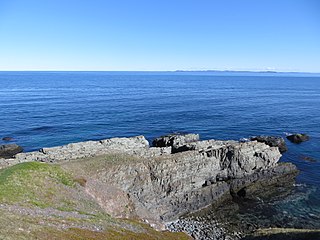
The Stratigraphy of the Cambrian period currently has several schemes used for ordering geologic formations from the period. The International Commission on Stratigraphy−ICS scheme has set a stratotype section for the base of the Cambrian, dated quite accurately to 538.8 ± 0.2 million years ago. Russian and Chinese scientists have developed a different scheme.
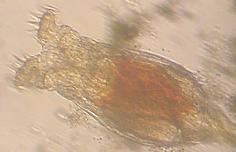
Gnathifera is a clade of generally small spiralians characterized by complex jaws made of chitin. It comprises the phyla Gnathostomulida, Rotifera, Micrognathozoa, and Chaetognatha. It may also include the Cycliophora.

Small carbonaceous fossils (SCFs) are sub-millimetric organic remains of organisms preserved in sedimentary strata.
Ceratophyton is a genus of Cambrian acritarch, around 100–200 µm in length, produced by a eukaryotic (metazoan?) organism.
Cephalonyx is a genus of filamentous acritarchs known from the Precambrian and early Cambrian.
Korilophyton is a genus of branching Cambrian acritarchs of presumed algal affinity.

The Læså Formation is a lower Cambrian unit exposed on the Baltic island Bornholm, comprising two members: the lower, the Broens Odde Member, colloquially and previously informally termed "green shales", a 100 m thick glauconitic silt-sandstone occasionally bearing extremely acritarch-rich phosphatic pebbles; gradually transitioning upwards into the upper, the 3 m thick Rispebjerg Member, a sandstone.
References
- ↑ Knoll, A. H.; Grotzinger, J. P.; Kaufman, A. J.; Kolosov, P. (1995). "Integrated approaches to terminal Proterozoic Stratigraphy: An Example from the Olenek Uplift, Northeastern Siberia". Precambrian Research. 73 (1–4): 251–270. Bibcode:1995PreR...73..251K. doi:10.1016/0301-9268(94)00081-2. PMID 11539551.
- ↑ Rubinstein, Claudia V.; Mángano, M. Gabriela; Buatois, Luis A. (December 2003). "Late Cambrian Acritarchs from the Santa Rosita Formation: Implications for the Cambrian-Ordovician Boundary in the Eastern Cordillera, Northwest Argentina" (PDF). Revista Brasileira de Paleontologia. 6: 43–48. Retrieved March 17, 2016.